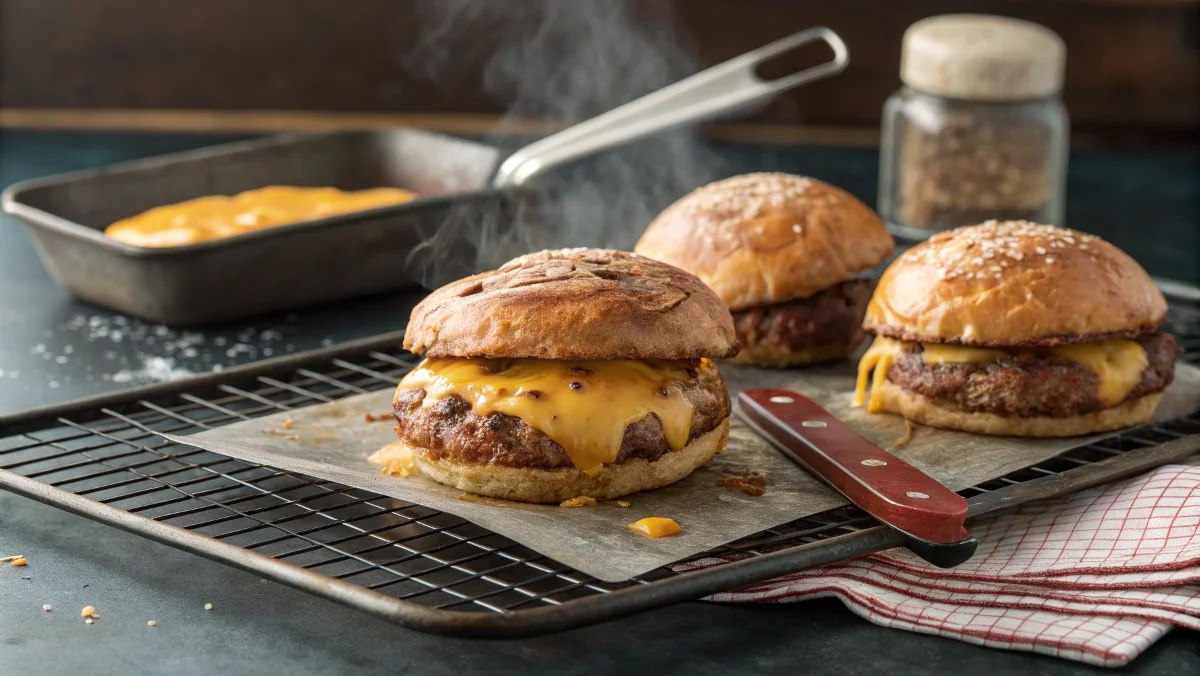Cooking burgers in the oven is an easy and effective way to prepare a delicious meal without the hassle of grilling or the mess of stovetop frying. Cooking Burgers at 400°F is the perfect method to achieve perfectly juicy burgers with minimal effort. With Cooking Burgers at 400°F, you can enjoy consistent results and delicious flavors every time. Whether you’re feeding a crowd or enjoying a quick weeknight dinner, this ultimate guide to oven-baked burgers covers everything you need to know, including cooking times, preparation tips, and doneness levels.
In this article, we’ll explore:
- The ideal cooking times for burgers at 400°F based on thickness and doneness preferences.
- A step-by-step guide to making the perfect burger in the oven.
- Tips for adding toppings, achieving crispy edges, and retaining juiciness.
- The importance of using a meat thermometer for accurate results.
- Answers to frequently asked questions about cooking burgers in the oven.
Let’s get started!
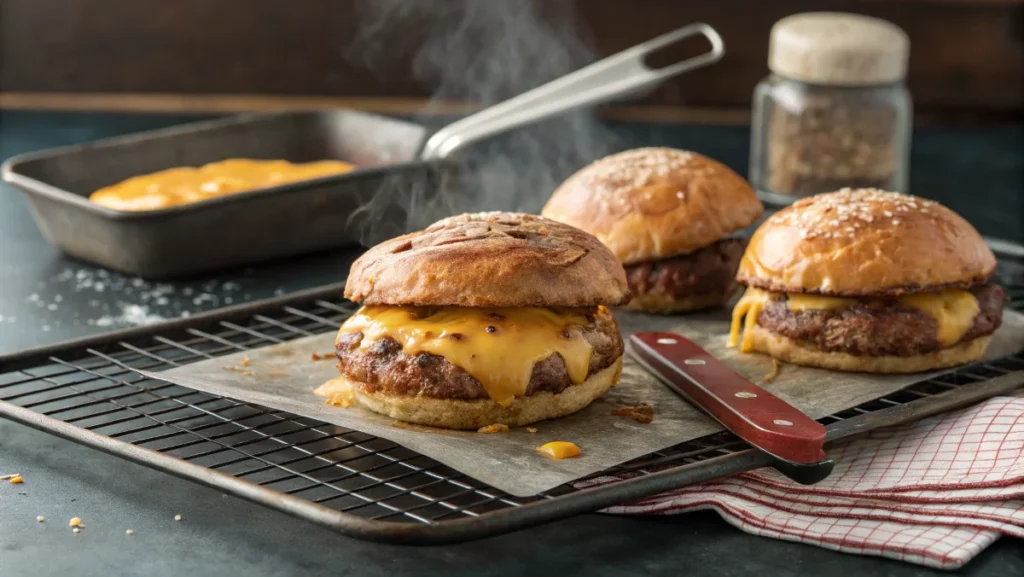
Table of Contents
Why 400°F Is the Perfect Temperature for Oven-Baked Burgers
Balancing Heat and Cooking Time
Cooking burgers at 400°F strikes the perfect balance between speed and even cooking. Lower temperatures (350°F) might result in undercooked centers, while higher temperatures (450°F) can overcook the outside before the inside reaches the desired doneness.
- Even Cooking: At 400°F, heat penetrates the meat uniformly, reducing the risk of raw spots.
- Quick Results: Burgers cook relatively fast at this temperature, making it a time-efficient method.
Retaining Juiciness
Unlike grilling, where juices can drip away, oven baking retains most of the burger’s natural moisture. This means you’ll end up with patties that are tender and juicy rather than dry.
Versatility in Cooking
Cooking Burgers at 400°F allows you to add toppings like cheese, onions, or mushrooms during the last few minutes of cooking. This convenience makes Cooking Burgers at 400°F an excellent choice for customizing your meal to suit your taste.
Pro Tip: For best results, always preheat your oven to 400°F and use a lined baking sheet to minimize cleanup.
Preparing Your Burgers for the Oven
Choosing the Right Ground Meat
The quality and fat content of your ground meat play a big role in the flavor and texture of your burgers.
- Ground Beef: An 80/20 blend (80% lean meat, 20% fat) is ideal for juicy, flavorful burgers.
- Alternatives: Turkey, chicken, or plant-based meat alternatives can also be used. Just adjust the cooking time as needed.
Forming the Patties
Properly shaped patties cook evenly and prevent over- or under-cooking:
- Divide the meat into even portions (usually 4-6 oz per patty).
- Gently form each portion into a disc about 3/4 inch thick.
- Create a shallow indentation in the center of each patty with your thumb to prevent it from puffing up during baking.
Seasoning the Burgers
- Classic Seasoning: Salt, pepper, garlic powder, and onion powder are simple yet flavorful options.
- Creative Flavors: Experiment with smoked paprika, chili powder, or Italian seasoning for a unique twist.
Prepping the Baking Sheet
Line a baking sheet with aluminum foil or parchment paper to prevent sticking. For even better results when Cooking Burgers at 400°F, place a wire rack on top of the sheet to allow excess grease to drip off, ensuring evenly cooked and juicy patties.
Pro Tip: Always bring the patties to room temperature (10-15 minutes) before baking. When Cooking Burgers at 400°F, this step ensures even cooking and helps the patties retain their juiciness.
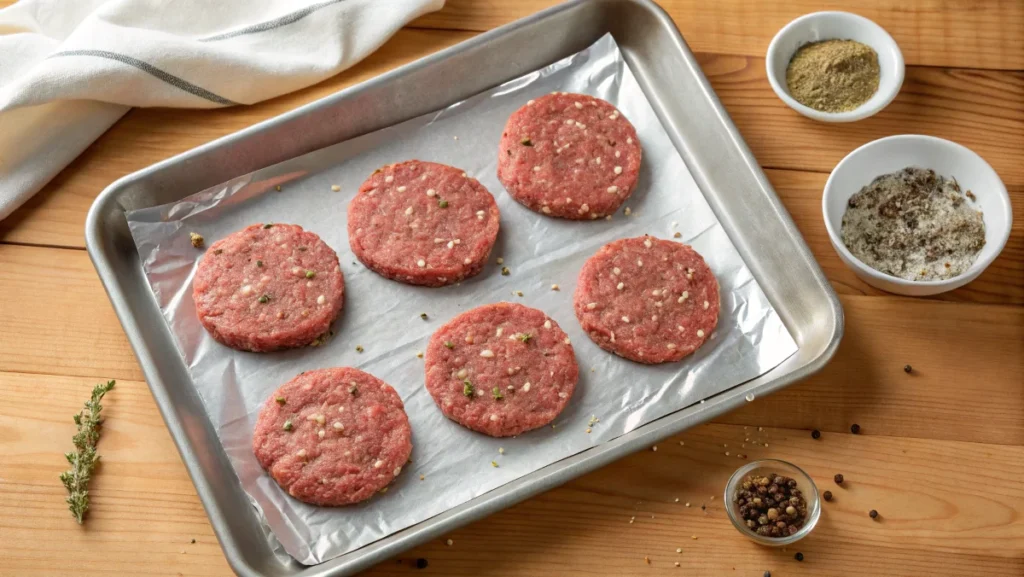
How to Cook Burgers at 400°F in the Oven
Step-by-Step Instructions
- Preheat the Oven: Set your oven to 400°F and let it fully preheat.
- Arrange the Patties: Place the prepared patties on the lined baking sheet, spacing them about 1 inch apart.
- Bake the Burgers:
- For medium-rare: Bake for 12-15 minutes.
- For medium: Bake for 15-18 minutes.
- For medium-well: Bake for 18-20 minutes.
- For well-done: Bake for 20-25 minutes.
Using a Meat Thermometer
A meat thermometer is essential for ensuring your burgers are cooked to the desired doneness:
- Medium-rare: 130-135°F
- Medium: 140-145°F
- Medium-well: 150-155°F
- Well-done: 160°F+
Insert the thermometer into the center of the patty for an accurate reading.
Adding Cheese or Toppings
If you want melted cheese or additional toppings:
- Add slices of cheese, sautéed onions, or mushrooms in the last 2 minutes of cooking.
- Return the burgers to the oven until the cheese melts or toppings are warmed.
Pro Tip: Avoid overcooking by checking the burgers 2-3 minutes before the minimum cooking time. For a deeper dive into the art of crafting culinary delights, explore Maki Sushi: Types, Ingredients, Popular Recipes & Health Benefits, which offers insights into creating balanced and flavorful meals.
Tips for Juicy and Flavorful Oven-Baked Burgers
Preventing Dryness
- Don’t Overmix: Overhandling the meat can make burgers tough.
- Choose the Right Fat Content: Use 20% fat in your ground meat for the best results.
- Rest Before Serving: Let the burgers rest for 5 minutes after cooking to allow the juices to redistribute.
Achieving a Crusty Exterior
- Broil for the last 2-3 minutes to achieve a golden, crispy crust.
- Use a wire rack to allow heat to circulate around the patties.
Infusing Flavor
- Marinate the Meat: Add Worcestershire sauce, soy sauce, or BBQ sauce to the meat mixture for extra flavor.
- Season Generously: Don’t skimp on salt and pepper—season both sides of the patties.
Pro Tip: Brush a light layer of olive oil on the patties before baking to enhance browning.
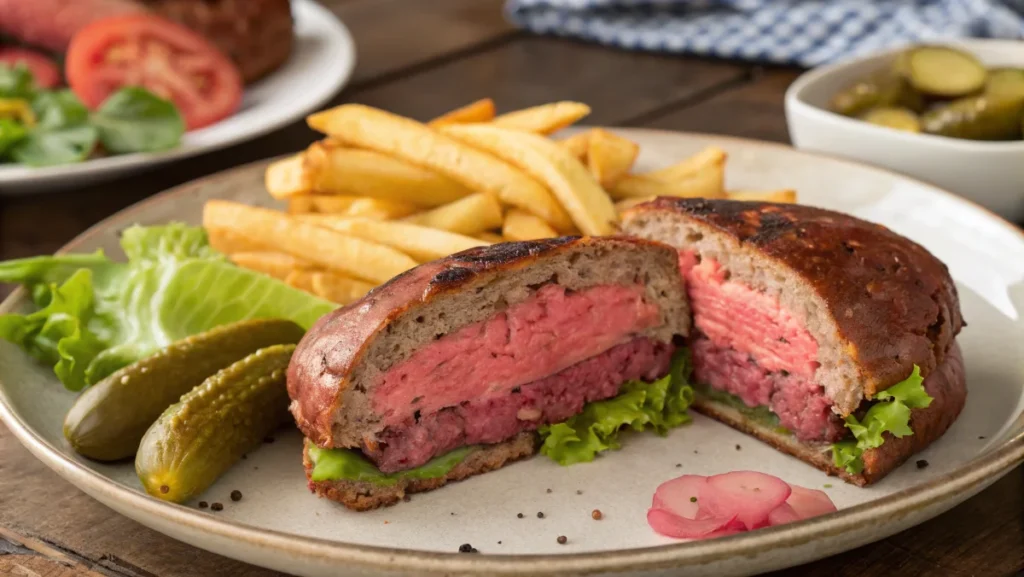
Adjusting Cooking Time for Different Burgers
Thicker vs. Thinner Patties
- Thicker Patties: Require longer cooking times. For a 1-inch thick patty, bake for 20-25 minutes.
- Thinner Patties: Cook faster. A 1/2-inch thick patty may only need 12-15 minutes.
Cooking Frozen Burgers
- Preheat the oven to 400°F.
- Bake frozen patties for 25-30 minutes, flipping halfway through.
- Always check the internal temperature (160°F) before serving.
Adjusting for Meat Types
- Turkey Burgers: Require an internal temperature of 165°F and typically take 20-25 minutes.
- Veggie Burgers: Bake for 12-15 minutes or until heated through.
Pro Tip: Keep an eye on the oven during the last few minutes to avoid overcooking, especially for leaner meats like turkey or chicken. For precise temperature guidelines in cooking, check out Is salmon 140 or 145? to ensure your meals are cooked to perfection.
Adding Toppings and Customizing Burgers
Classic Toppings
Elevate your burgers with these timeless options:
- Cheese: American, cheddar, Swiss, or blue cheese for a creamy, tangy touch.
- Vegetables: Lettuce, tomatoes, onions, and pickles for a fresh crunch.
- Condiments: Ketchup, mustard, mayo, or BBQ sauce for added flavor.
Gourmet Additions
Take your burgers to the next level with these creative toppings:
- Avocado Slices: Add creaminess and healthy fats.
- Sautéed Mushrooms: Provide an earthy, umami flavor.
- Caramelized Onions: Bring a sweet and savory element to your burger.
- Fried Egg: Perfect for a brunch-style burger.
Timing for Toppings
- Add toppings like cheese during the last 2 minutes of cooking.
- Fresh toppings, like lettuce and tomatoes, should be added after cooking to maintain texture.
Pro Tip: Create a “build-your-own-burger” station for gatherings, letting everyone customize their patties to their liking.
Benefits of Cooking Burgers in the Oven
Uniform Cooking
The consistent heat in an oven ensures that burgers cook evenly, reducing the chances of undercooked centers or burnt edges.
Healthier Option
Using a wire rack allows excess grease to drip away from the patties, making them a leaner option compared to pan-frying.
Convenience
- Hands-Free Cooking: No need to constantly flip or monitor the patties.
- Large Batches: Easily cook multiple patties at once, making it ideal for family dinners or parties.
Year-Round Availability
Unlike grilling, which depends on the weather, baking burgers in the oven is a method you can use any time of the year.
Pro Tip: Line your baking sheet with aluminum foil or parchment paper for easy cleanup. For a lighter alternative to bread, consider using lettuce wraps and explore what type of lettuce is best for lettuce wraps to make your meals both healthy and delicious.
Troubleshooting Common Issues
Dry Burgers
- Cause: Overcooking or using lean meat.
- Solution: Opt for 80/20 ground beef and remove burgers from the oven once they reach the desired temperature. Let them rest before serving.
Uneven Cooking
- Cause: Patties of different thicknesses or not preheating the oven.
- Solution: Make sure all patties are uniform in size and thickness. Always preheat the oven to 400°F before baking.
Soggy Burgers
- Cause: Excess grease buildup on the baking sheet.
- Solution: Use a wire rack to allow grease to drip away and create a crisp exterior.
Bland Flavor
- Cause: Insufficient seasoning.
- Solution: Generously season the meat with salt, pepper, and your favorite spices before baking.
Pro Tip: Always use a meat thermometer to ensure perfectly cooked burgers without guesswork. When Cooking Burgers at 400°F, this tool helps you achieve the ideal doneness while keeping the patties juicy and flavorful.
Storing and Reheating Oven-Baked Burgers
Storing Leftovers
- Refrigeration: Store cooked burgers in an airtight container in the refrigerator for up to 3 days.
- Freezing: Wrap each patty individually in plastic wrap or aluminum foil, then place them in a freezer-safe bag. Freeze for up to 3 months.
Reheating Burgers
To retain flavor and moisture, follow these methods:
- Oven: Preheat to 350°F and heat burgers for 10-12 minutes.
- Stovetop: Heat on a skillet over medium-low heat for 3-4 minutes per side.
- Microwave: Heat in 30-second intervals, but be cautious as this can dry out the burgers.
Reviving Juiciness
Add a splash of water or beef broth when reheating in the oven or microwave to keep the patties moist. This is especially effective when Cooking Burgers at 400°F, as it helps retain their juicy texture during reheating.
Pro Tip: Avoid reheating burgers more than once to prevent a loss of texture and flavor.
Pairing Oven-Baked Burgers with Sides
Classic Side Dishes
- French Fries: Crispy and golden, they’re the ultimate burger companion.
- Onion Rings: Crunchy and flavorful, perfect for dipping in ketchup or ranch dressing.
- Coleslaw: A tangy, creamy side that complements the richness of the burger.
Healthy Options
- Salads: Serve with a fresh green salad or a quinoa-based salad for a lighter meal.
- Grilled Vegetables: Zucchini, bell peppers, or asparagus make excellent sides.
- Sweet Potato Fries: A nutritious alternative to regular fries with a sweet, savory twist.
Unique Pairings
- Mac and Cheese: Creamy, cheesy, and indulgent—great for comfort food lovers.
- Corn on the Cob: Buttered and seasoned corn adds a burst of freshness to the meal.
- Baked Beans: A smoky, hearty option that pairs well with oven-baked burgers.
Pro Tip: Offer a variety of sauces and dips to accompany your sides, such as spicy mayo, garlic aioli, or honey mustard.
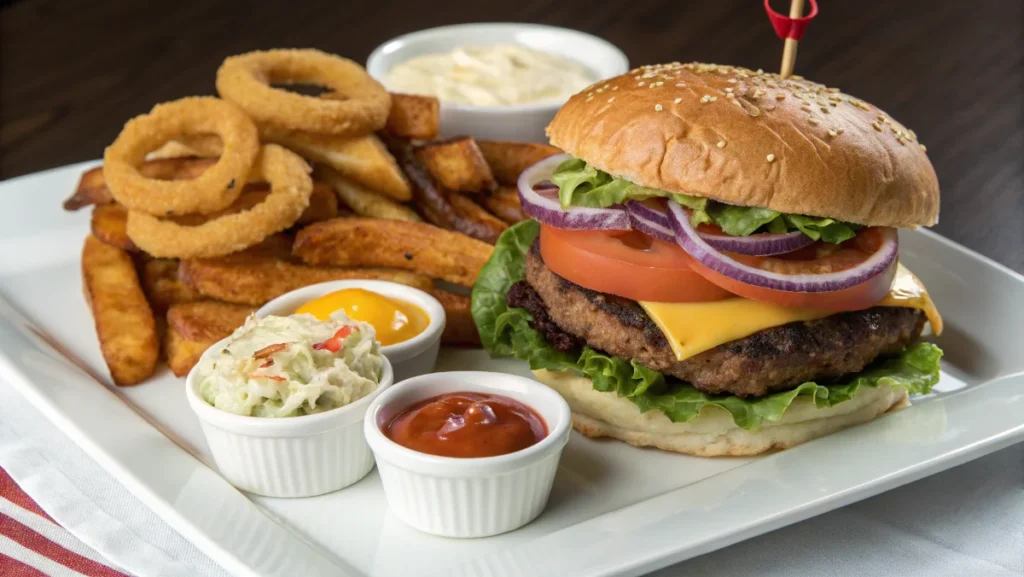
FAQs About Cooking Burgers
1. What Is the 5-6-7 Rule for Burgers?
The 5-6-7 rule is a tried-and-true technique for grilling burgers based on your preferred level of doneness. This method ensures consistent results and makes it easy to achieve the perfect burger every time. Here’s how it works:
- 5 minutes per side for medium-rare (internal temperature: 130-135°F).
- 6 minutes per side for medium (internal temperature: 140-145°F).
- 7 minutes per side for medium-well (internal temperature: 150-155°F).
This rule applies to 1/2-inch thick patties cooked over medium-high heat on a grill. However, the principles can be adapted to oven cooking, where temperatures are more controlled, and the process is more hands-off.
For burgers baked in the oven at 400°F, the total cooking time typically ranges as follows:
- Medium-rare: 12-15 minutes.
- Medium: 15-18 minutes.
- Medium-well: 18-20 minutes.
- Well-done: 20-25 minutes.
If you’re aiming for that classic grill-like crust, flipping the patties halfway through baking (at the 6-10 minute mark) can help achieve this texture.
Pro Tip: Always use a meat thermometer to ensure precise doneness. This eliminates guesswork and guarantees that your burgers are cooked safely while remaining juicy.
2. How Many Minutes Per Side for Burgers at 400°F?
When baking burgers at 400°F, you don’t necessarily have to cook them per side as you would on a grill. The oven’s heat envelops the patties evenly, allowing them to cook without flipping. However, if you prefer flipping for a crispier, more even crust, here’s a guide to timing:
- 6-8 minutes per side for medium-rare.
- 8-10 minutes per side for medium.
- 10-12 minutes per side for medium-well.
- 12-15 minutes per side for well-done.
For a hands-free approach, simply cook the burgers for the total time without flipping. Using a wire rack on a baking sheet is particularly effective, as it allows heat to circulate around the patties and grease to drip off, resulting in evenly cooked burgers.
Tip: Relying on cooking time alone can sometimes lead to overcooking or undercooking. Using a meat thermometer ensures your burgers hit the following internal temperatures:
- Medium-rare: 130-135°F.
- Medium: 140-145°F.
- Medium-well: 150-155°F.
- Well-done: 160°F or higher.
If you’re cooking frozen burgers, plan for an additional 5-7 minutes of baking time, as they take longer to heat through.
3. Do I Need to Flip a Burger in an Oven?
Flipping burgers in the oven is not a strict requirement. Unlike grilling or stovetop cooking, where flipping is essential for even cooking, the consistent heat in the oven ensures patties cook uniformly from all sides. That said, when Cooking Burgers at 400°F, flipping the burgers halfway through baking does have some benefits:
- Even Browning: Flipping ensures both sides develop a golden crust, adding texture and flavor.
- Preventing Sticking: Turning the patties prevents them from sticking to the baking sheet if it isn’t well-lined.
If you’re using a wire rack, flipping becomes optional. The rack allows air to circulate underneath the burgers, promoting even cooking and browning on all sides without the need for turning.
When to Flip:
- For 1-inch thick patties, flip after 8-10 minutes to ensure an even sear.
- For thinner patties, flipping isn’t necessary, as they cook through more quickly.
Pro Tip: Line your baking sheet with aluminum foil or parchment paper for easy cleanup, especially if you’re not using a wire rack.
4. How Often Should I Flip Burgers at 400°F?
If you choose to flip burgers while baking, it’s best to do so only once halfway through the cooking process. Flipping too often can disrupt the cooking process, releasing juices and potentially drying out the burgers. A single flip ensures even browning without compromising juiciness.
For burgers baked at 400°F, follow this guideline:
- Flip patties at the 8-10 minute mark for a total cooking time of 18-20 minutes.
Avoid flipping frozen burgers more than once, as they require more time to develop a stable structure during cooking. Excessive flipping can cause them to fall apart.
Pro Tip: Preheat a wire rack over a foil-lined baking sheet before placing your patties on it. This minimizes the need for flipping and ensures grease drips away for a healthier result.
Conclusion: Cooking Burgers at 400°F Made Easy
Cooking Burgers at 400°F in the oven is a simple yet versatile method that guarantees juicy, flavorful patties. From choosing the right meat to customizing with gourmet toppings and pairing with delicious sides, Cooking Burgers at 400°F allows you to create a satisfying meal that rivals any restaurant. For more inspiration on crafting delicious homemade meals, explore the ultimate guide to Supreme Pizza and elevate your next culinary adventure!

